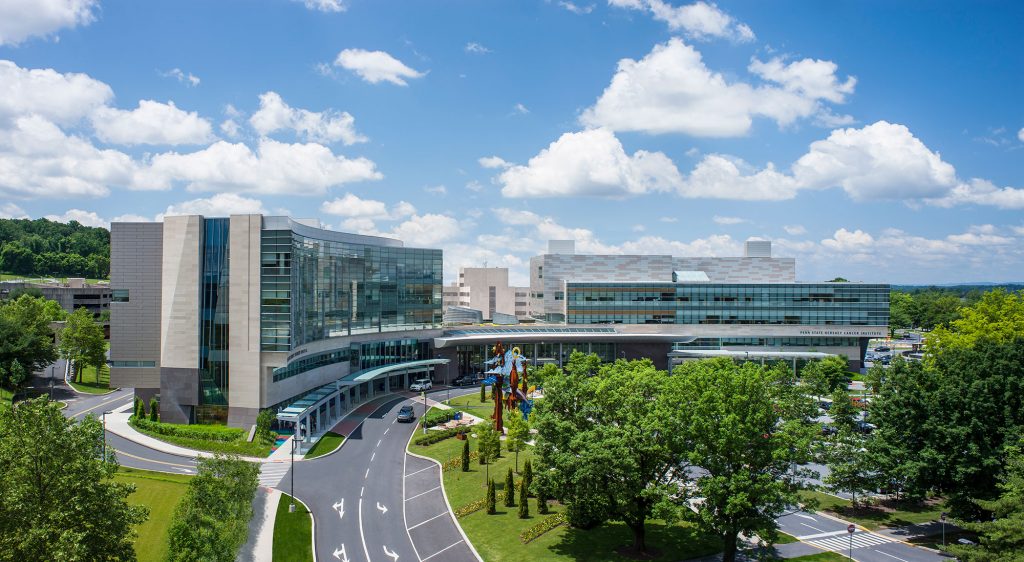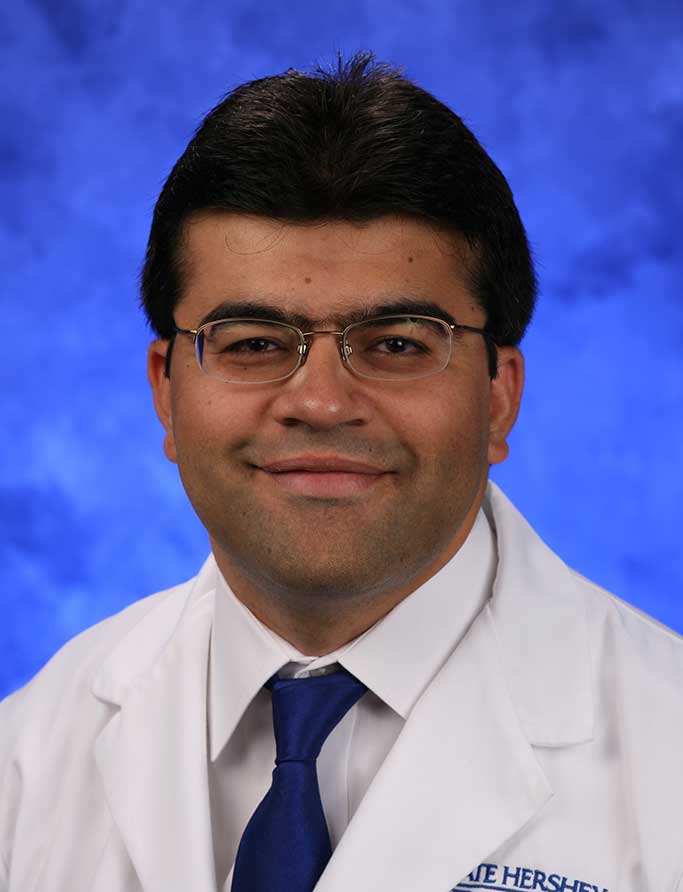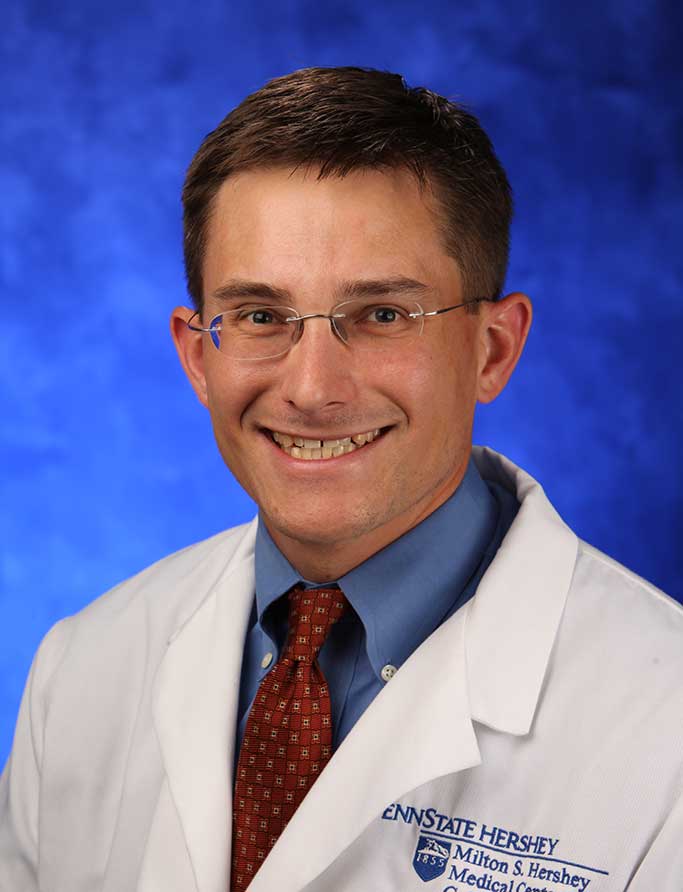Jump to topic
Search
Program Details
The Division of Vascular Surgery at Penn State Health Milton S. Hershey Medical Center has a long history of training vascular surgery fellows. The institution was approved by RRC for an integrated vascular surgery residency in 2009, and its first integrated vascular surgery resident graduated in 2016.
The five-year comprehensive clinical training program in vascular and endovascular surgery matches medical students directly into vascular training. General surgery and vascular surgery are incorporated over the five years.
The program is based at Penn State Health Milton S. Hershey Medical Center, with electives available to rotate with division faculty at Mount Nittany Medical Center. A complete schedule of didactic sessions and clinical conferences supplements the patient care and research activities of the Vascular Surgery Service.
The clinical expertise of the division includes all components of the diagnosis and treatment of vascular disorders. Patients with a wide variety of arterial, venous and lymphatic diseases receive evaluation from a whole-patient perspective. The surgical faculty employ numerous methods and technologies for vascular reconstruction in patients requiring invasive therapy, and offer medical management for those with milder forms of disease. The entire spectrum of endovascular therapy is provided through the integrated framework of Penn State Heart and Vascular Institute. The Division of Vascular Surgery provides non-invasive vascular testing as an integral part of patient management, and is both nationally and internationally recognized for its excellence.
The academic mission of the division embraces scholarship in both clinical and related basic sciences. The Vascular Surgery Residency trainees have the opportunity to pursue research work that has led to presentation and publication of their work at regional and national conferences. The division participates in major national clinical trials and is active at all levels in developing quality standards for noninvasive testing.
Learn More about the Residency
General Application Information
Penn State College of Medicine is a participant in ERAS and the National Residency Matching Program (NRMP) Match. All application material must be submitted through ERAS. Applications will not be received outside of ERAS. All candidates will need to be registered with the NRMP; no positions will be offered outside of the match.
Application deadline is Oct. 4. Applicants are invited to check the status of applications by email through MyERAS. All email correspondence regarding applications should be conducted through MyERAS to avoid delays.
Applicants with suitable qualifications will be invited to interview and visit with the department.
Application Requirements
Applications will be reviewed in their entirety.
- U.S. clinical experience is not required; however, vascular surgery electives and/or vascular surgery experience is preferred.
- The recruitment team prefers to see graduation from medical school within five years of submitting the ERAS application. However, this is dependent upon what clinical/research experience applicants have had since graduating from medical school.
- USMLE Step 1/COMLEX 1 is required to be selected for an interview. Step 2 is not absolutely essential to be selected for an interview, but is required to be ranked by the program. USMLE scores should be no less than 190, or COMLEX no less than 500 for osteopathic graduates). Osteopathic graduates are encouraged to take USMLE Step 1. PGY-1 must take USMLE Step 3 before completing the intern year.
- There is no official limit for attempting Step 1 or Step 2; however, the number of times the applicant has taken the exam may impact the application. An invitation to interview will be based on the entire application and not simply exam scores.
- Three letters of recommendation are required, with one from a vascular surgeon; a dean’s letter, medical school transcripts, curriculum vitae and personal statement are also required.
- ECFMG certification must be supplied before beginning as a resident.
- The institution currently accepts residents on J-1 visas only; however, the application process and applicable fees are the responsibility of the applicant.
Couples Matches
For applicants who have been invited to interview and who are couples matching with an applicant interviewing with another department at Penn State Health Milton S. Hershey Medical Center, the Vascular Surgery Residency will be happy to help coordinate with the other department as much as possible. Such applicants should contact the program.
Interview Process
The program typically interviews 30 to 35 individuals each year over three interview dates between October and January. The interview process is designed to put the applicant at ease and provide detailed information about the program.
All interviews and social events for the 2023-2024 academic year will be conducted virtually through Microsoft Teams.
Virtual Tour
Penn State Health
Penn State Health is a multi-hospital health system serving patients and communities across 29 counties of Pennsylvania. Its mission is to improve health through patient care, research, education and community outreach.
In December 2017, the system partnered with Highmark Health to facilitate creation of a value-based, community care network in the region. The shared goal of Highmark and Penn State Health is to ensure patients in the community are within:
- 10 minutes of a Penn State Health primary care provider
- 20 minutes of Penn State Health specialty care
- 30 minutes of a Penn State Health acute care facility
Learn more about Penn State Health

Penn State Health Children’s Hospital (left), Penn State Health Milton S. Hershey Medical Center (center) and Penn State Cancer Institute (right)
Penn State Health Milton S. Hershey Medical Center
500 University Dr., Hershey, Pa., 17033 (Derry Township, Dauphin County)
- The health system’s 647-bed flagship teaching and research hospital
- The only medical facility in Pennsylvania accredited as both an adult and a pediatric Level I (highest-level) trauma center
- Dedicated surgical, neuroscience, cardiovascular, trauma and medical intensive care units
- Accredited Life Lion critical-care transport providing more than 1,100 helicopter and approximately 750 ground ambulance transports per year
- More than 1,300 faculty members and more than 650 residents and fellows
- Approximately 29,000 admissions, 73,000 emergency department visits, 1.1 million outpatient visits and 33,000 surgical procedures annually
- Designated as a Magnet hospital since 2007
Learn more about Milton S. Hershey Medical Center
Penn State Health Children’s Hospital
600 University Dr., Hershey, Pa. 17033 (Derry Township, Dauphin County)
- An eight-story, 263,000-square-foot-facility built in 2013 and expanded in 2020
- 160 licensed pediatric beds, 26-bed pediatric intensive care unit and a 56-bed neonatal intensive care unit
- Level IV (highest-level) neonatal intensive care unit
- Level I quaternary (highest-level) pediatric intensive care unit
- Level I (highest-level) pediatric trauma center designation
- Intermediate care unit
- Dedicated pediatric operating rooms
- More than 150,000 pediatric outpatient visits, 20,000 pediatric emergency room visits, and approximately 5,000 pediatric patient discharges annually
Welcome to Hershey
More About Hershey
Interested in learning more about living and working in Hershey, Pa.? See details here:
Wellness, including emotional, spiritual, social and physical health, is a crucial component to training and to becoming a professional, compassionate and resilient physician. Self-care is a skill which must be continually practiced and reinforced. Penn State College of Medicine and Penn State Health are committed to addressing wellness among residents and fellows, with multiple resources readily available.
Institutional resources
- Visit BeWell – a health program designed to support Penn State Health employees
- See Penn State College of Medicine wellness resources here
- Employee Health Care Concierge and Case Management Service
- Partners in Medicine
Moving to a new city with your family does not have to be stressful. Residency programs have assisted many significant others with finding employment. There is also a GME-Wide Partners in Medicine (PIM) group that offers networking opportunities as well as various social and community oriented activities. - The Doctors Kienle Center for Humanistic Medicine
- Active and easily accessed Office of Professional Mental Health
Graduate medical education resources
Institutional Resources
Penn State Health and Penn State College of Medicine celebrate, embrace and support the diversity of all patients, faculty, staff, students and trainees.
Office for Diversity, Equity and Inclusion
In keeping with this, Penn State Health has an active Office for Diversity, Equity and Inclusion with various programs, networks and resource groups, including:
- Talks and lectures on diversity, equity and inclusion through the Inclusion Academy
- Regular events on topics such as eradicating racism and creating a culture of inclusiveness
- Many Business Employee Resource Groups (BERGs), including:
- Disability Business Employee Resource Group
- Interfaith Business Employee Resource Group
- LGBTQ+ Business Employee Resource Group
- Military and Veterans Business Employee Resource Group
- Multicultural Business Employee Resource Group
- NextGen Business Employee Resource Group
- Black Physician Professional Staff Association – Resource Group
- Hispanic Professional Association
- Asian Physician and Professional Staff Association
- International Workforce Inclusion
Learn more about the Penn State Health Office for Diversity, Equity and Inclusion
Learn more about the College of Medicine’s Office for Diversity, Equity and Belonging
Office for Culturally Responsive Health Care Education
The vision at Penn State College of Medicine and Penn State Health is to equip learners with the knowledge, skills and attitudes they will need to provide culturally excellent health care and research for an increasingly diverse U.S. population. The Office for Culturally Responsive Health Care Education was formed to help meet that goal.
Learn more about the Office for Culturally Responsive Health Care Education
Office for a Respectful Learning Environment
In addition, the institution does not tolerate discrimination, biases, microaggression, harassment or learner mistreatment of any kind, and any concerns are immediately addressed by the Office for a Respectful Learning Environment.
Learn more about the Office for a Respectful Learning Environment
Network of Under-represented Residents and Fellows
The Network of Under-represented Residents and Fellows (NURF) is a group of diverse residents and fellows representing all specialties. NURF’s goal is to promote cultural diversity in the residency programs through community involvement, mentorship with diverse faculty, professional networking and support for the recruitment of diverse medical students into the residency programs.
NURF is sponsored by the Penn State College of Medicine Graduate Medical Education Office and the Penn State Health Office for Diversity, Equity and Inclusion.
Mailing Address
Penn State Health Milton S. Hershey Medical Center
Division of Vascular Surgery
P.O. Box 850, MC H053
Hershey, PA 17033-0850
General Contact Information
Phone: 717-531-8898
Fax: 717-531-4151
Curriculum Details
Teaching in the Vascular Surgery Residency is performed using the following teaching methods:
- Mandatory conferences
- Mandatory rotation in an attending’s office once per week.
- Direct teaching in the operating room and during patient care.
Assessment Methods for Residents
- Verbal feedback during daily rounds and walk rounds
- Written self-evaluation twice a year
- Written evaluation by physician assistants at conclusion of rotation
- Written evaluation by faculty at conclusion of rotation
- Written evaluation by nurses twice a year
- Written evaluation by inpatients and outpatients once a month
Program Evaluation Assessment Methods
- Written evaluation at completion of each rotation
- Written evaluation of the program at the completion of each year
- Performance on VSITE examination (yearly)
Level of Supervision
The nighttime and weekend attending call schedule is available to all through SmartWeb and the vascular surgery office. An attending is designated to be the rounder each weekday. The rounder is responsible for all daytime and intra-operative consults and transfers.
Training Includes
- Fluoroscopy training program
- Advanced Trauma Life Support (ATLS)
- Advanced Cardiac Life Support (ACLS)
- Annual CME funds
- Travel opportunities
- Leads and loupes
Educational Resources
- American College of Surgeons Fundamentals of Surgery Curriculum
- Anatomic Exposures in Vascular Surgery
- Fundamentals of Vascular and Endovascular Simulator
- Rutherford Vascular Surgery
- Surgical Council on Resident Education (SCORE)
- Vascular Surgery Surgical Council on Resident Education (VSCORE)
The Vascular Surgery Residency (integrated 0/5 program) rotation schedule includes:
PGY-1
- Anesthesia/cardiology
- Cardiothoracic (CT) surgery
- Heart and vascular intensive care unit
- Night float
- Plastic surgery
- Surgical intensive care unit
- Trauma
- Vascular surgery
PGY-2
- General surgery (UPMC Pinnacle)
- Heart and vascular intensive care unit
- Plastic surgery
- Surgical intensive care unit/anesthesia
- Thoracic surgery
- Trauma
- Vascular surgery
PGY-3
- General surgery (UPMC Pinnacle)
- Interventional radiology
- Surgical intensive care unit
- Thoracic surgery
- Vascular surgery
- Vascular surgery (Mount Nittany)
- Vascular surgery (UPMC Pinnacle)
PGY-4
- Interventional radiology
- Vascular surgery
- Vascular surgery (Mount Nittany)
- Vascular surgery (UPMC Pinnacle)
PGY-5
- Vascular surgery
- Vascular surgery (Mount Nittany)
Tuesday
- 7 to 8 a.m. the second Thursday of each month: Heart and Vascular Institute basic science lecture
Thursday
- 7 to 8 a.m. weekly: General surgery education lectures
- 7 to 8 a.m. weekly: Vascular preoperative conference and Morbidity and Mortality
- 7 to 8 a.m. quarterly: Office of Graduate Medical Education ACGME Core Competencies Lecture Series
- 8 to 9 a.m. weekly: Vascular teaching conference
- 9 to 10 a.m. weekly: Vascular skills, CBL, Journal Club and interesting articles
There are also surgical and Heart and Vascular Institute grand rounds, along with surgery Morbidity and Mortality.
Vascular Teaching Conference
- Bi-annual cadaver and simulation lab
- Vascular science didactic lab
- Varied lectures by residents, fellows and faculty members
General Surgery Education and Training
- Topics and location are assigned weekly
- PGY-1 through PGY-3 residents are required to attend these sessions if deemed relevant by the Assistant Program Director
- If sessions are not relevant, vascular skills, case-based learning or sessions in the Vascular Lab will be assigned
Attendance Requirements
Residents on vacation are excused from all conferences. Other than this exception or other extenuating circumstances previously approved by the program director and reported to the program coordinator, residents are expected to attend all conferences. If at an off-site rotation, residents must use a Microsoft Teams meeting link to sign in to the vascular teaching conference, vascular preoperative conference and Morbidity and Mortality. Residents must participate in 75 percent of all required conferences.
Resident Honors and Recognitions
Penn State College of Medicine and Penn State Health Milton S. Hershey Medical Center accept ongoing nominations for the Exceptional Moments in Teaching award.
The award, given monthly by the Office for a Respectful Learning Environment, accepts nominations from College of Medicine students who are invited to submit narratives about faculty members, residents, fellows, nurses or any other educators who challenge them and provide an exceptional learning experience. See more about the award here.
Previous nominees from the Vascular Surgery Residency are listed here. Click the + next to a nominee name to read their nominator’s comments.
The annual Resident/Fellow Research Day is held each year (with exception of during the COVID-19 pandemic) on and around the Penn State Health Milton S. Hershey Medical Center campus.
The intent of the event is to provide an opportunity for residents and fellows to showcase their research accomplishments to their peers in other clinical departments, as well as their colleagues in the basic sciences.
Learn more about Resident/Fellow Research Day here.
Previous presentations from the Vascular Surgery Residency are listed here.
Latest News from Surgery

Latest News from Penn State Heart and Vascular Institute





